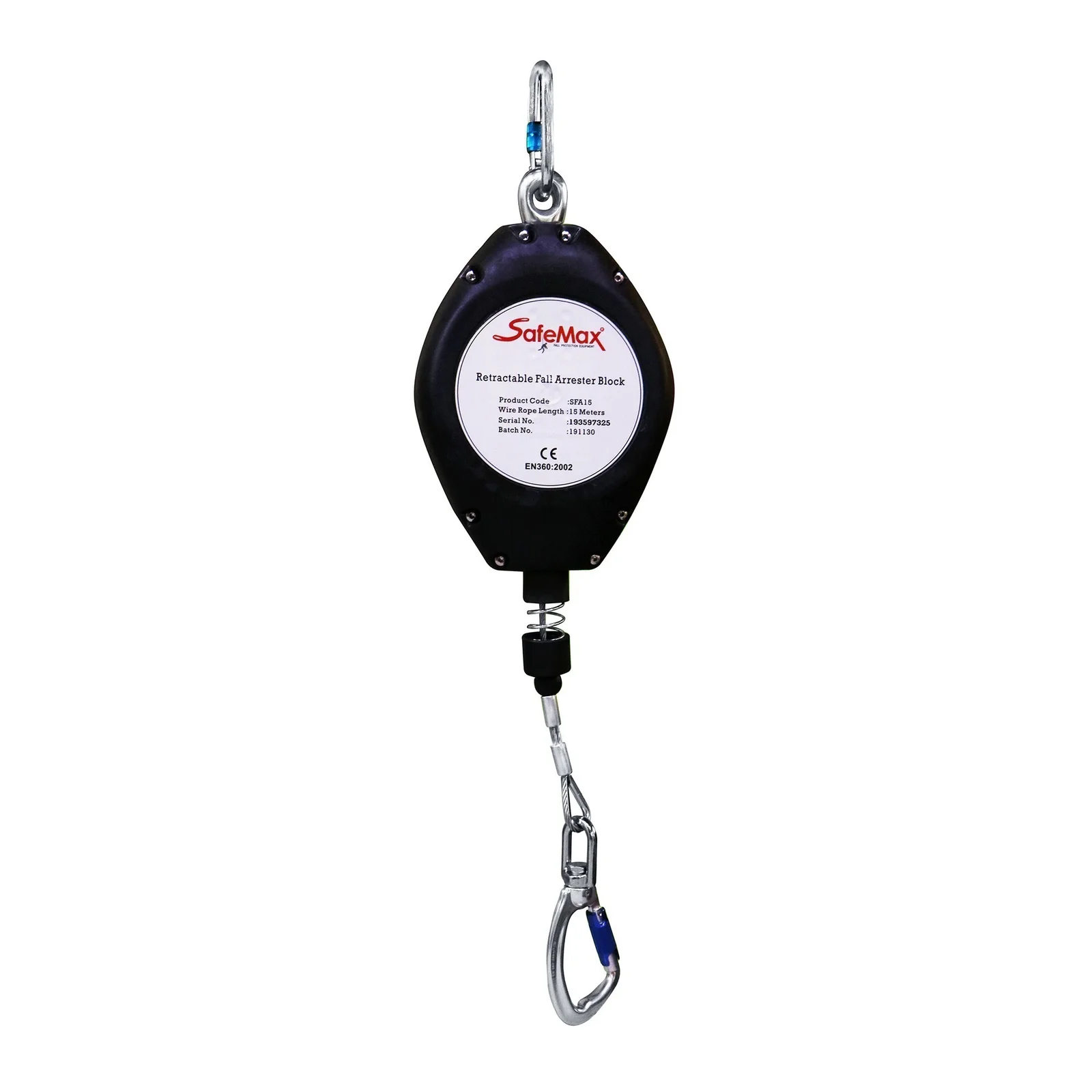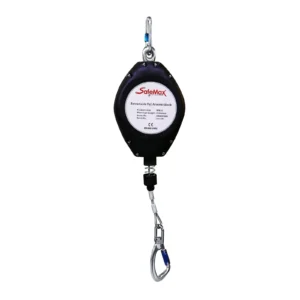Are you looking for a reliable and efficient solution to ensure safety at heights?
Look no further than retractable fall arrestors. In this comprehensive guide, we will explore everything you need to know about retractable fall arrestors and how they can help protect workers in hazardous environments. Retractable fall arrestors are innovative safety devices designed to prevent falls and protect workers from serious injuries. With their retractable lifelines, these devices provide workers with the freedom to move around while still being securely attached to an anchor point. They are ideal for various industries such as construction, manufacturing, and maintenance, where working at heights is a common occurrence. In this guide, we will delve into the different types of retractable fall arrestors available, their features, and how to choose the right one for your specific needs. We will also discuss important safety regulations and guidelines to follow when using retractable fall arrestors. Don’t compromise on safety. Join us as we dive into the world of retractable fall arrestors and discover the ultimate solution for protecting workers at heights.
GET IT NOW
1. Understanding Fall Protection Regulations and Standards
Fall protection regulations and standards play a crucial role in ensuring worker safety. Here are some key points to consider:
1. OSHA Requirements
The Occupational Safety and Health Administration (OSHA) mandates fall protection measures in various industries. For example:
- In general industry workplaces, fall protection must be provided at elevations of four feet or more.
- In construction, fall protection is required at six feet or higher.
- Longshoring operations have an eight-foot requirement.
2. Guardrails and Toe-boards
Employers must guard floor holes and provide guardrails around elevated open-sided platforms. These measures prevent accidental falls.
3. Other Fall Protection Methods
Besides retractable fall arrestors, consider safety harnesses, safety nets, stair railings, and handrails.
2. How Retractable Fall Arrestors Work
Retractable fall arrestors (also known as self-retracting lifelines) are essential components of personal protective equipment (PPE). Here’s how they function:
Components
A retractable fall arrestor typically comprises two main components:
- Lanyard: The lanyard is a flexible line or cable that connects to the worker’s safety harness. It allows the worker to move freely while remaining connected to the fall arrest system.
- Housing Unit: The housing unit contains the retractable mechanism. When the lanyard is pulled out (extended), it retracts back into the housing unit when released.
Retraction Mechanism
- The retraction mechanism inside the housing unit is responsible for automatically winding up the lanyard when not in use.
- It ensures that the lanyard remains taut and doesn’t create trip hazards or entanglements during work.
Automatic Braking System
- The critical feature of a retractable fall arrestor is its automatic braking system.
- When a fall occurs, the sudden tension on the lanyard activates this braking system.
- The braking system engages immediately, preventing the worker from falling any farther.
- The fall distance is limited to just a few inches, significantly reducing the risk of serious injuries.
Energy Absorption
- Some retractable fall arrestors also incorporate energy-absorbing elements.
- These elements help dissipate the impact force generated during a fall, further enhancing safety.
- Energy absorption minimizes the stress on the worker’s body and the anchorage point.
Regular Inspection and Maintenance
- Proper maintenance and regular inspection are crucial for ensuring the effectiveness of retractable fall arrestors.
- Inspect the housing unit, lanyard, and braking system for signs of wear, damage, or malfunction.
- Follow the manufacturer’s guidelines for maintenance intervals and replacement of worn components.
3. Types of Retractable Fall Arrestors
Let’s explore different types of retractable fall arrestors:
Webbing Strap (RAPTOR W)
- Suitable for sensitive surfaces (e.g., facades, aircraft construction).
- Less suitable for humid environments.
- Equipped with a Trilock carabiner.
Steel Cable (RAPTOR C)
- Ideal for general applications.
- Suitable for horizontal use.
- Not recommended for sensitive surfaces.
- Equipped with a Trilock carabiner.
Stainless Steel Cable (RAPTOR CS)
- Suitable for coastal regions and aggressive environments (e.g., chemical industry).
- Less suitable for sensitive surfaces.
- Equipped with a Snap Hook carabiner.
Remember to choose the right type based on your specific needs and working conditions.
4. Choosing the Right Retractable Fall Arrestor
Consider the following factors:
Type of Work
- Identify the specific tasks you’ll be performing. Different industries and job roles have varying requirements.
- For example:
- Construction: Construction workers often need fall arrestors with longer reach due to working at heights on scaffolding or rooftops.
- Maintenance: Maintenance technicians may require a compact and lightweight fall arrestor for ease of movement.
- Industrial Tasks: Industrial settings might involve heavy machinery, so robust fall arrestors are necessary.
Environment
- Surface conditions play a crucial role in fall arrestor selection:
- Sensitive Surfaces: If you’re working on delicate surfaces (e.g., solar panels, fragile roofs), choose a fall arrestor with a low impact force to prevent damage.
- Abrasive Surfaces: For rough or abrasive environments (e.g., concrete, steel structures), opt for a durable fall arrestor with reinforced materials.
User’s Weight
- Ensure that the fall arrestor can support the user’s weight. Consider the following:
- Weight Capacity: Fall arrestors have weight limits specified by the manufacturer. Choose one that accommodates your weight (including tools and equipment).
- Dynamic Load: Account for the dynamic load during a fall. The impact force increases due to acceleration. A higher-rated fall arrestor provides better protection.
Fall Hazards
- Evaluate the specific risks associated with your work environment:
- Free Fall Distance: Determine the maximum free fall distance you might encounter. Some fall arrestors limit free fall to inches, while others allow longer distances.
- Swing Hazards: If there’s a risk of swinging or pendulum motion during a fall, consider a fall arrestor with a swivel top connector to prevent entanglement.
- Edge Protection: If working near edges (e.g., roofs, ledges), choose a fall arrestor with edge-tested certification to prevent damage to the lifeline.
5. Proper Usage and Maintenance
Visual Checks
- Before Use: Inspect the fall arrestor before each work session. Look for any signs of wear, damage, or malfunction.
- Housing Unit: Examine the housing unit for cracks, dents, or corrosion.
- Lanyard: Check the lanyard for fraying, cuts, or kinks.
- Braking System: Ensure the braking mechanism engages smoothly when the lanyard is pulled.
- After Use: After completing your work, perform another visual check to identify any issues that may have arisen during the task.
Modular Design
- Many modern fall arrestors feature a modular design, allowing individual components to be replaced.
- Advantages:
- Cost-Effective: Instead of replacing the entire fall arrestor, you can replace specific parts (e.g., lanyard, braking system) as needed.
- Time-Saving: Modular components reduce inspection time and simplify maintenance.
- Inspect and Replace:
- If any part shows signs of wear or damage, replace it promptly. Follow the manufacturer’s guidelines for compatible replacement components.
Fall Indicators
- Fall indicators provide crucial information about the fall arrestor’s history:
- Housing Indicator: Some fall arrestors have a visual indicator on the housing unit. It changes color if the fall arrestor has been subjected to a fall.
- Carabiner Indicator: Check the carabiner (attachment point) for similar indicators.
Why It Matters
- If the fall arrestor has been involved in a fall, it may need thorough inspection or replacement.
- Regularly check these indicators to ensure the fall arrestor’s integrity.
6. Common Misconceptions
“I don’t need fall protection.”
- Fact: Fall protection is essential for anyone working at height, whether it’s on a construction site, a rooftop, or any elevated surface.
- Why?
- Falls are a leading cause of workplace injuries and fatalities.
- Even a fall from a relatively low height can result in severe injuries.
- Proper fall protection equipment significantly reduces the risk of accidents.
“I can use any fall arrestor.”
- Fact: Choosing the right fall arrestor is crucial for safety and efficiency.
- Considerations:
- Type of Work: Assess your specific tasks (e.g., construction, maintenance, industrial work).
- Environment: Surface conditions (sensitive or abrasive) impact fall arrestor selection.
- User’s Weight: Ensure the fall arrestor supports your weight.
- Fall Hazards: Evaluate risks related to free fall distance, swing hazards, and edge protection.
“Fall arrestors last forever.”
- Fact: Fall arrestors require regular inspections and maintenance.
- Why?
- Wear and Tear: Over time, components experience wear, stress, and exposure to environmental factors.
- Safety Assurance: Regular inspections ensure that the fall arrestor functions correctly.
- Modular Design: Some fall arrestors allow individual component replacement, reducing costs and inspection time.
7. Training and Certification
Training
- Why It Matters:
- Proper training ensures that workers understand how to use fall protection equipment effectively.
- It covers essential topics such as:
- Identifying fall hazards.
- Selecting and inspecting the right equipment.
- Proper donning and doffing procedures.
- Emergency response protocols.
- Why It Matters:
Benefits
- Safety: Trained workers are less likely to make mistakes that compromise safety.
- Efficiency: Efficient use of fall arrestors reduces downtime and increases productivity.
- Compliance: Compliance with safety regulations and standards.
Certification
- Why It’s Necessary:
- Certification ensures that users have demonstrated competence in using fall arrestors.
- It verifies that they understand safety protocols and can handle fall protection equipment correctly.
- Certification Process:
- Users typically undergo formal training (as mentioned above).
- They then take an assessment or practical test to earn certification.
- Certification may need renewal periodically (e.g., every few years).
- Why It’s Necessary:
The importance of training and certification for using retractable fall arrestors.
Enhanced Safety
Comprehensive training equips users with the knowledge to handle retractable fall arrestors safely. From understanding proper attachment points to knowing how to respond in emergencies, certified individuals minimize risks and enhance workplace safety.
Regulatory Compliance
Compliance with safety regulations is a must in high-risk environments. Proper training ensures that users understand and adhere to industry standards and legal requirements, avoiding penalties and legal liabilities.
Risk Mitigation
Inadequate training increases the likelihood of accidents and injuries. Certified operators possess the skills to identify potential hazards, assess risks, and take preventive measures, reducing the occurrence of workplace incidents.
Equipment Optimization
Proficiently trained individuals know how to inspect, maintain, and utilize retractable fall arrestors effectively. This knowledge prolongs the lifespan of equipment, optimizing its performance and minimizing downtime.
Reputation Building
Prioritizing safety through training and certification enhances organizational reputation. Clients and stakeholders value companies that prioritize employee well-being, fostering trust and credibility within the industry.
Cost Savings
Investing in training and certification yields long-term cost savings. By preventing accidents and injuries, companies avoid costly medical expenses, legal fees, and productivity losses associated with workplace incidents.
Empowered Workforce
Training empowers employees with the confidence and skills needed to execute their duties competently. Certified individuals feel more empowered and valued, leading to increased morale and productivity in the workplace.


